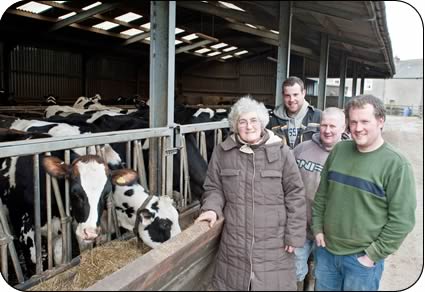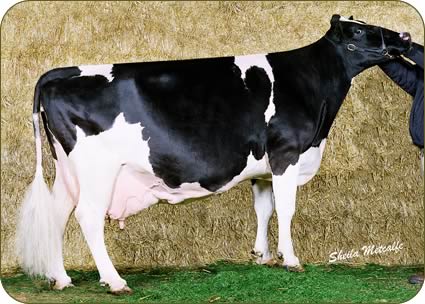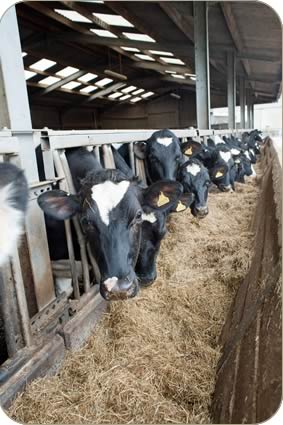Jennifer MacKenzie is an agricultural photo journalist with almost 30 year's experience. Operating from her base in Cumbria, Jennifer undertakes mainly industry-related freelance writing and photography.
Dunnerdale Holsteins Top Honours
Genetics coupled with attention to detail in day to day management earned
Dunnerdale Holsteins top honours in a revived dairy production competition.
The herd of 100 pedigree milkers topped NMR’s Cumbria Herd Competition, which was disbanded 10 years ago following the foot and mouth crisis, winning the Harrison & Hetherington Trophy for combined weight of fat and protein. The herd also won the Border and Lakeland Club Cup for its record Lifetime Daily Yield of 18.6kg of milk per cow.
 |
| Doreen Boow, Phil Muncaster, Paul Norman and Stephen Boow with Dunnerdale heifers |
The award was made to Stephen Boow who farms with his mother Doreen at Corney Hall, Bootle. The herd averaged 821kg of fat and protein in the year to the end of September 2011 - but the accolade was tinged with sadness following the tragic death of Stephen’s father, Wilson last April.
“Dad would have been proud as punch that the herd had won the award,” said a delighted Stephen, whose sister Alison Walker farms at nearby Waberthwaite with husband Colin.
Wilson had been the third generation of his family to farm a traditional hill unit in Seathwaite in South Cumbria, concentrating on sheep breeding until he established a pedigree dairy herd 30 years ago.
The family took the opportunity to buy Corney Hall in 1996 and further their interests in Holstein breeding and milk production on the farm’s 210 acres of good grass growing land.
In the last 16 years the number of cows in milk has doubled and investment during the early days before expansion in embryos from North America left some strong cow families resulting in a high production, high indexing herd with sales of sought-after surplus youngstock providing a substantial income.
The herd’s genetic progress also earned it Holstein UK’s prestigious Master Breeder Award in 2010, made annually only to a handful of herds when home-bred milking animals are awarded points based on production, longevity and classification. Currently there are 39 EX, 40VG, 16 good plus and three good cows.
 |
|
Dunnerdale Pre Sabrina, now 18 and enjoying retirement! |
Of the original eight ET heifers which were mainly daughters of Prelude, seven classified EX, two of which went on to produce 110 tonnes of milk, and the eighth was classified VG. The matriarch of one of the strongest cow families was Dunnerdale Pre Sabrina, classified EX94.
Two of her descendants, Dunnerdale Sword and Spring, have been sold this year to AI company GB Bulls. At 18 years old, Sabrina is now enjoying her retirement.
Almost equalling Sabrina’s success, the Pretzel family which goes back to Eric Dew Conductor Peggy, has also made its mark on the herd as has been the Aldina family which goes back to NVF Triple Threat Amanda, with Triple Threat being a red carrier bull.
Since the embryo purchases, few females have been brought into the herd. A 12 month old Stella heifer from Jewett by Shoremar Milan was bought at the 1998 Transatlantic Breeders sale and she is in her 10th lactation and has produced 169 tonnes.
The choice of AI sires over the years - including Hilltopper Warden, Ronnybrook Prelude, Startmore Rudolph, Braedale Goldwyn - has helped maintain high yields which relatively quickly topped 10,000 kg after moving to Corney Hall.
Stephen has been involved with the sire selection over the last couple of years and AI bulls currently in use are Pine-Tree Sid and Gillette bulls Windbrook, Stanley Cup and Jordan, Crackholm Fever, and Comestar Lauthority and Lavenguard, with the emphasis on breeding for type.
“We believe that if we breed for the right type of dairy cow the production follows,” said Stephen.
“Ten years ago we began milking three times a day which we continued for a good 12 months. At that point our production hit an average 12,336 kg a cow but with a reduced weight of combined fat and protein of 815 kg.
“Our yield has remained pretty stable since we returned to twice daily milking and in 305 days to September last year we averaged 11,271 kg at 4.08 per cent butterfat and 3.2 protein,” he added. The herd is CIS recorded.
Since reverting to twice daily milking, cows are given as long a period between milkings as possible - with times at 6am and 6pm.
The award of the lifetime daily yield reflects the longevity of the cows which are currently averaging around five lactations. This not only benefits production but it reduces the number of heifer replacements required.
 |
| Dunnerdale Holstein heifers |
One of the main facets of the business is the sale of up to 40 newly calved heifers each year, either privately or through the Wright Manley sales at Beeston Castle, a centre which Wilson always enjoyed attending.
In January 2011 he topped the market at 5,400gns for the champion Dunnerdale Toystory Gail, a daughter of Toystory bred from eight generations of Excellent or Very Good dams tracing back to A Jim‐Mar‐D Astronaut Gail (Ex) 11. In reserve was another Toystory daughter, Dunnerdale Toystory Maud 2nd who has two VG dams and the Boows claimed the sale’s top four prices.
The champion, after a very competitive bout of bidding from many different clients including two telephone bidders, sold to JT Parkin of Barnard Castle, Co Durham, a regular purchaser of Dunnerdale heifers for his Barnard herd.
Stephen and Doreen are dedicated to managing the herd from the rearing of the new born heifer calves (Doreen’s job along with providing back-up for other work) to the feeding and cow health. They are helped by part time workers Phil Muncaster and Paul Norman.
Since the wet spring of 2009 the milking cows have been housed all the year - dry cows and heifers are turned out during the summer months.
The milkers are fed a semi-TMR based on silage which is taken off 90 acres for first and second cut with 70 acres for third cut - last year an unusually early first cut at the beginning of May enabled a fourth cut of 30 acres.
Last year’s first cut analysed at 55% dry matter, 72.9 D value, 11.7ME, 13.8 protein, 12.2 sugar. The second cut taken in mid June was almost as dry at 45% DM, 71.3D, 11.4ME, 15.3 protein and 10.7 sugar.
A further 500 high dry matter round bales are made for feeding dry cows and heifers.
Barley for wholecrop is grown for three years as part of a re-seeding programme which now includes high sugar grasses.
As well as grass silage and wholecrop - wheat can be grown as an alternative on rented ground - the diet for M plus 35kg of milk includes molasses, a blend from Dugdale Nutrition, minerals and protected fats. It remains similar throughout the year. The cows are topped up with concentrate to 6kg maximum in the parlour.
As a result of the cows being housed all year, the Boows have made better use of the grassland and slurry, the latter saving 40% bought in fertiliser.
The herd is virtually closed and is vaccinated for BVD and Leptospirosis. Heifers get Huskvac before their first grazing season.
Heifers are bucket reared on milk replacer and coarse mix and are then introduced to the TMR at four months old to help develop the rumen and grow frame with the aim to calve them at 24 months old and increase lifetime yield.
As well as the 210 owner occupied acres, 26 acres are taken on a long term rent plus 50 acres of summer grazing.
The Boows were sold on Lleyn sheep not long after moving to Corney Hall and 135 older ewes lamb in January - this year they have 264 Texel and Beltex cross lambs. A further 150 shearlings and two shear ewes lamb from mid-March, half of which are bred pure and the remainder crossed with the Texel and Beltex.
In mid April 50 hoggs are lambed and around 70 geld hoggs are run on. Finished lambs are sold in Lancaster mart.
A small Texel flock now numbering nine ewes and seven hoggs was started with the purchase of pedigree in lamb ewes three years ago to breed rams for use at home and to sell. Ewes are AI'd to the Beltex.

